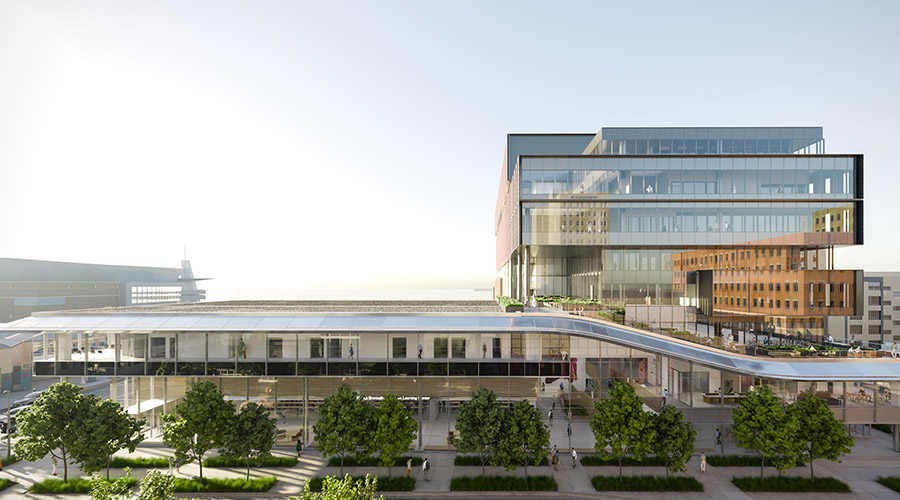It may not be sexy to anyone but engineers, but the central utility plant is a vital component of any hospital facility. A significant first cost and a driver of long-term operational costs for most hospitals, typically, the CUP is housed in a separate building designed as part of a new healthcare project.
As a lead design engineer, I have utilized Modular Central Utility Plants (MCUPs) in two recent healthcare projects for Banner Ironwood Medical Center and Highland Community Replacement Hospital. In both projects, the utilization of the MCUPs led to innovations in project delivery and dramatic reductions in first costs for new healthcare construction. Furthermore, in both cases, the MCUP was designed to contain chillers, cooling towers, boilers, water treatment systems, pumps, heat exchangers, pressure reducing stations, VFDs, offices and toilets.
The new modular central plants have many advantages when compared to traditional central utility plants: (1) they can be built off-site, thereby reducing construction time and disruption; (2) they are customizable and are easily scalable to meet changing demands, ensuring you don’t under or over-build capacity; and (3) they can reduce operating and maintenance costs by improving efficiency and reliability. Of course, it is not quite a simple matter of buy and plug-in; the design process is different from the traditional design approach and requires the ability to understand the installation of a system of this type. There are also several challenges in ensuring that the installed system meets the design intent. This article will discuss the advantages of using a MCUP for hospital design and also examines the challenges that need to be overcome to ensure that the maximum benefits are truly achieved.
Benefits of a MCUP
Lower installation cost
The cost of construction has been found to be 10-15% less than conventional Central Utility Plants (CUPs).
Reduced space requirement
Since the MCUP is not a part of the building, it will not contribute to the Net Gross Area of the hospital. Therefore, the client is permitted to fulfill department space requirements without compromise.
Scalability
CUPs for hospital projects are typically constructed to anticipate future demands. As such, they generally occupy more space than what is actually required. . Conversely, the MCUP is built in modules and the hospital can easily add modules as the hospital grows or the demands for existing space increases. For example, Highland Community Replacement Hospital was designed to be a 60-bed facility day-1 [is day-1 correct or does it go before facility] with plans to expand to 120 beds in the future. While the MCUP is designed to meet the requirements of a 120-bed hospital, only modules with a capacity to serve day-1 loads will be installed initially. The complete MCUP will include three (3) chillers, three (3) boilers and three (3) cooling towers; whereas, the day-1 installation comprises two (2) chillers, two (2) cooling towers and two (2) boilers, along with the supporting accessories. Thus, the upfront capital costs are only spent on the equipment and associated enclosures that are needed to support day-1 loads.
Simplified field installation
The system has a single point hydronic, electrical and control connection which requires less site coordination during the construction process.
Faster project completion (Reduce lead time)
Since the plant is assembled and tested in the factory, it can be transported to the site and re-assembled at a faster rate than building a traditional CUP.
Single source responsibility
The entire plant is provided by one manufacturer, thus lowering the risk to contractors, designers and the owner.
Cost of operation
The MCUP can be provided on a Design-Build or Design-Build-Operate- Maintain basis which may or may not include third party ownership. This unique arrangement allows the owner to shift performance risk to the manufacturer, and can be used to ensure the long term integrity of high performance technologies. Using the lease arrangement frees up the hospital to focus on its core business and can decrease operating costs.
Challenges encountered when using MCUP
Inexperienced designers
MCUP is relatively new to the healthcare construction market. Accordingly, the task of designing and delivering such a system depends on the designer and the manufacturer that is chosen to fabricate the plant. An inexperienced designer is faced with the daunting task of ensuring that there is no cost overrun and that the system specification is very stringent to ensure that the fabricator of the plant does not compromise the quality of the final product. A client must ensure that any engineering company they choose has prior experience in designing a MCUP.
Insufficient specification
The construction documents should contain a complete specification section for a MCUP. This specification should detail all equipment that will be included in the MCUP. At a minimum, it should contain the following (as applicable to the specified design):
1. Structural steel base
2. Pumps and motors
3. Piping, valves, and fittings
4. Control valves
5. Air separator
6. Expansion tank
7. Domestic and make up water
8. Tower sump sweeper system
9. Chillers
10. Cooling towers
11. Steam or Hot water boilers
12. Deaerators
13. Water softeners
14. Heat exchangers
15. Steam pressure reducing stations
16. Equipment enclosure
17. Variable frequency drives
18. Combination starters
19. Switchboards
20. Sequencing controls
21. Pressure, flow, and/or temperature transmitters
22. BAS interface
Inexperienced manufacturers
After designing my first MCUP, I realized that there were many manufacturers claiming to have vast experience in the production of such systems. Unfortunately, I realized the hard way that this was simply not the case. It is very important that manufacturers that are listed in the specification have a minimum of least 10 years of experience in the manufacturing of modular plants. The packaged plant manufacturer should be listed by ETL as an approved manufacturer of factory assembled chiller/boiler plants. The equipment should bear the ETL listing and label before shipment from the factory. This listing must cover the entire packaged plant as fabricated and assembled at the manufacturer's factory. A separate listing for just the components is unacceptable. My two top MCUP manufacturers are Systecon and Johnson’s Control. Both companies meet the criteria listed above.
Complete factory testing
Chillers, boilers and sometimes pumps are tested at the factory level for capacity and efficiency; the tests are mostly done at full load with other operating load points tested to a much lesser extent. Although chillers and boilers are the heart of the cooling and heating system (and the two most expensive components and biggest energy consumers within the system), they do not drive total plant efficiency by themselves. The performance of the whole system also depends on other factors such as plant configuration, pump selection, piping design, and component control. The optimum plant performance has a lot to do with the energy efficiency of the system over the entire load spectrum. Factory testing of the entire system validates performance and identifies intrinsic deficiencies that can be corrected before the plant is shipped.
For the MCUP designed and installed for Highland Community Replacement Hospital in Mississippi, the testing was used as a pre-commissioning service. This was very beneficial to the owner because the manufacturer was able to rigorously test the plant before it was delivered to site. Factory efficiency testing of the chilled and/or hot water systems was done at 25, 50, 75 and 100% of the design flow of the system. For all of these percentages, the following values were recorded: flow, system total dynamic head, kW. It was also specified that the manufacturer demonstrate the transition points at which standby pump(s) are added and subtracted to achieve optimum system efficiency. These rigorous test regimes ensured that the MCUP for the hospital performed at a very high efficiency level.
10 Lessons learned from designing and installing a MCUP
1. The designer should ensure that all system components are selected by the designer and ensure that any selected items are approved products.
2. The submittal review process for the MCUP is very tedious and lengthy – time should be put aside for comprehensive submittal review. Designers should ensure that the submittal process is not dictated by the manufacturer and enough time is spent combing through the hundreds of pages of submittal information.
3. Equipment that does meet the specification standards should be rejected because such equipment will compromise the performance of the central plant.
4. Only manufacturers that have the experience in fabricating this type of plant should be included in the specification. The specification should clearly state that such manufacturers should have at least 10 years of experience manufacturing modular systems.
5. The rigorous factory test, although very expensive, should be included in the MCUP specification.
6. The plant should be modeled using 3D software in order to ensure full equipment coordination and that the maintenance clearances are achieved.
7. Sprinkler systems should be installed as a part of the factory fabrication process.
8. Fire alarm and conduits should be installed as part of the factory fabrication process.
9. Designers should ensure that all sanitary and storm drains in the MCUP yard are fully coordinated with the civil engineering team.
10. Vent pipes from the heating system should be vented away from the cooling tower locations.
Garold “Gary” Hamilton is a principal and the healthcare engineering lead in the DC office for SmithgroupJJR. Email him at gary.hamilton@smithgroupjjr.com.
.

 Barriers to Infection: Rethinking Mattress Cleaning
Barriers to Infection: Rethinking Mattress Cleaning Over 1 Million Individuals Affected in Community Health Center Data Breach
Over 1 Million Individuals Affected in Community Health Center Data Breach Prospect Medical Holdings to Sell Crozer Health to Non-Profit Consortium
Prospect Medical Holdings to Sell Crozer Health to Non-Profit Consortium The Top States for Pest Infestations
The Top States for Pest Infestations Ground Broken on Wichita Biomedical Campus Project
Ground Broken on Wichita Biomedical Campus Project